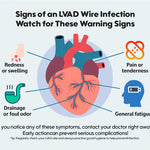
How long can you live with an LVAD?
Your doctor must have discussed with you how an LVAD or left ventricular assist device supports the functioning of the weak heart and how it will work to relieve your symptoms and improve the quality of life. But still, if you are unsure about it, then it is completely normal. As far as the big decision like this is concerned, you should know about the LVAD procedure, its survival rate, life expectancy, and what kind of life you can expect afterward.
Struggling to make the right decision? We will walk you through everything you need to know, from how the device will change your life to recovery to challenges that can come afterwards. So that you will be able to make an informed decision.

What is an LVAD? Why do you need it?
An LVAD is a mechanical pump that is implanted in your heart after a terminal condition like advanced heart failure. This is a medical heart device that improves the flow of blood and supplies oxygenated blood to each organ in your body. LVAD has been used to improve the symptoms and quality of life.
So, when might someone actually need an LVAD? Here are some of the scenarios:
- Your health has severely declined due to heart failure, and you need the support of an LVAD.
- Your heart is in a recovery phase and needs some support until it fully recovers.
- You are not suitable for a heart transplant, so you may need to live a life with an LVAD.
- You are waiting for a suitable heart donor and may need an LVAD as a bridge to transplant.
How does LVAD work?
For you to understand how LVAD works, you must know about its components. The LVAD device consists of a pump that moves blood from the ventricles to the aorta, a driveline that connects the pump to the controller outside the body, and then there are batteries that are the power source of the controller and pump. The controller? It's like the brain of the device that monitors and handles the device, and also alerts you if the pump stops for some reason or the battery dies.
The pump circulates the blood and supplies oxygen-rich blood to the whole body to allow normal functioning. But unlike the minor treatments, it’s not a decision that you should take lightly. That is why you need to talk with your doctor in detail so that he can openly discuss LVAD device benefits and risks. It will give you an idea to make a choice that’s right for you.

Success Rates of LVAD Surgery:
If you are still exploring a beginner’s guide to LVAD, know that you should also need to understand the success rates and what individual factors can affect it. The truth is, each one of us is unique and may have unique factors that can affect the success rates. Generally, these factors may include the health of the patient, age of the patient, use of the latest medical technology, and the post-operative care. However, the success rates have increased in recent years. Thanks to medical advancements and innovations. On average, 80% to 85% of patients live a good quality of life in the first year after LVAD implantation, and around 75% experience no recurring symptoms. So, that means short-term survival rates are high after LVAD. But long-term survival rates can vary according to the unique condition of each patient.
LVAD vs Heart Transplant, Which one is better?
If you have been diagnosed with heart failure, your doctor might have talked about the possibility of a heart transplant. A heart transplant is actually a permanent treatment that will eradicate the cause and symptoms of heart failure completely, as it totally replaces a damaged heart with a new, healthy heart from a deceased donor.
Then why is there a need for an LVAD? Because not everyone is eligible for a heart transplant. Unlike a heart transplant, LVAD does not cure the condition; it simply compensates for the loss of function of the heart and improves the circulation of blood. LVAD is just another way to manage heart failure.
Although a heart transplant is a permanent treatment, it is not suitable for every patient. You may need an LVAD as a destination therapy for the rest of your life because your general health cannot support the new heart. If your doctor suggests that you need support until you go for a heart transplant, then you have to go for LVAD implantation before you get a transplanted heart.
Life Expectancy after LVAD and Heart Transplant:
Do you know that according to systematic data in 2018, there was no significant difference between LVAD and Heart Transplant with reference to the mortality rate after 1 year? Yes, it is true. The study tells us that life expectancy after an LVAD and Heart Transplant is not something that totally depends on the procedure and what technique used to implant the LVAD. In fact, it depends on the number of patients and medical factors.
Let’s discuss the life expectancy of each procedure and the factors affecting it.
How long can you live with a heart transplant?
Almost 89% of patients who received a heart transplant live after 1 year, and more than half of those patients live a life for over a decade after their surgery.
It is hard to predict how long someone can live after a heart transplant, and that is obvious because every patient’s situation is unique, even if they have the same disease. It will be more difficult if a person is dealing with other health issues like diabetes and high blood pressure.
Another study in 2019 suggested that the average life expectancy of a heart transplant is 9.4 years.
How long can you live with an LVAD?
There is no exact formula to tell how long someone can live with an LVAD, as it really depends on the person. As discussed before, a number of factors affect it. On average, though, a patient with LVAD has an average life expectancy of 4 to 5 years. We know that, in comparison, LVAD life expectancy is not what you expected, but still, it’s a life-saving device. Still, it is a vital option for those waiting for a donor heart or for patients who completely rely on the LVAD device.
Longest surviving LVAD patient:
Many patients have survived over a decade after having an LVAD implantation. Let’s talk about these patients who are inspiring us every day while living a good quality of life.
Mayra Rodriguez is a 42-year-old woman from New Jersey who has completed 16 years living with an LVAD HeartMate 2 device. She said she is not just living but enjoying her life with her family and friends, and feels fortunate about it.
Her case has been documented in a medical report as the longest LVAD survivor and is on ongoing support with the same HeartMate II LVAD that was originally implanted 16 years ago. This highlights both the durability of the device and her spirit to maintain the device in order to live longer with a good quality of life.
Factors that can affect your life expectancy after an LVAD:
Some of the factors that can affect life expectancy after an LVAD are listed below:
- General health of the patient
- Cause of heart failure
- Age of the patient
- Presence of other medical problems like pulmonary hypertension, kidney problems, or diabetes.
- Number of complications after the LVAD
- Experience of a doctor in performing LVAD implantation
- Post-operative care and management
- Proper device management
- Mental health support
- Positive history of infection
- Lifestyle
- Consumption of alcohol and smoking
- Nutritional status
Why is post-operative care and lifestyle modification necessary?
Your recovery does not end with the hospital discharge; it's just a new beginning. But what should you do? You must follow your doctor’s instructions on care after LVAD implantation and learn to manage the device effectively. Why is it necessary? When you take care of yourself and your device, take proper medications prescribed, and attend regular follow-up appointments, then it reduces the chance of infection and other problems like this. These factors support your recovery and keep you in good health, which is indirectly linked to the longer lifespan of the device and better life expectancy.

Recognize early warning signs of LVAD device impairment:
Although your doctor will give you and your caregiver advice on how to manage your device, he will also guide you to recognize the warning signs. What are these signs that you should watch out for?
Report immediately when you see any sign of dizziness, chest pain, shortness of breath, or restlessness, as these indicate that your LVAD is not working and your body isn’t getting enough blood to function.
The controller of your LVAD device may also tell you about the pump failure. It rings an alarm or vibrates to tell you that something is wrong. Make it a habit to listen for the usual LVAD pump’s sound and get help fast if you hear something that is unusual.
Why do you think it is necessary? LVAD pump failure causes a sudden drop in blood pressure and increases your heart rate. If the pump does not work for a long time, you may notice swelling or fluid retention in your legs and feet. So, you've got to do something about it, as it can really make all the difference.

Tips to increase life expectancy after LVAD:
As we talked about before, there are some individual or patient factors that can affect life expectancy after LVAD. Some of these factors are modifiable, which means you can modify them and take control to minimize the chances of complications. Here are some of the tips to increase the possibility of a longer life expectancy after LVAD:
- Take proper medications on time and monitor your health.
- Keep an extra pair of batteries with you all the time and regularly check them.
- Follow device care instructions and do not compromise on the driveline safety, as the infection can reduce overall life expectancy.
- Carry your LVAD device with proper LVAD-specific clothing that prevents tugging on the driveline and reduces malfunctioning.
- Invest in LVAD apparel and accessories and buy products from a brand like LVADGear. They offer premium-quality LVAD vests that not only accommodate LVAD perfectly but also allow you to move freely without any anxiety.
- Do not miss your appointment with your doctor in a follow-up routine.
- Report immediately to the emergency department if you feel any of the warning signs mentioned above.
- If you are unable to switch off the alarms and are experiencing severe symptoms, go to the emergency room.
Conclusion
You need to understand that no one thing or any hard and fast rule is there that can directly increase life expectancy after an LVAD. While it may not offer the same life expectancy as a heart transplant, it is still a lifeline, especially for people who aren’t eligible for a transplant or are waiting for a suitable donor. However, understanding factors that can affect life expectancy can help you or your loved ones make informed decisions about heart treatment. Always consult your doctor about the best treatment options according to your specific condition.
FAQs
What happens if your LVAD battery suddenly stops working?
If your battery suddenly stops working, your LVAD device will stop working, which means your heart will not be able to supply enough blood to the body, which can be life-threatening. It is the main reason that Patients are advised to keep an extra set of batteries and a power cable with them. The controller also beeps an alarm to alert its user if the battery power is low.
What are the disadvantages of having an LVAD?
One of the disadvantages of having an LVAD is that it demands a modified lifestyle, increased risk of infection through the driveline, blood clot formation, and stroke.
How do you die with an LVAD?
If an LVAD suddenly stops working, and there is no backup in the initial hours of the critical period, then there is a chance that a person’s heart deteriorates and causes heart failure and even death.
What is the difference between LVAD and a Pacemaker?
An LVAD is a mechanical pump that assists a weak heart in pumping blood out of the ventricle. However, the pacemaker is implanted to treat the abnormal rhythm of the heart by generating electrical signals.
Is it possible for LVAD patients to live alone?
Yes, it is possible for some LVAD patients to live alone, but it depends on their overall health, ability to care for the device, and emergency backup. Many patients are trained to manage battery changes, respond to alarms, and perform daily maintenance. However, it is best to have a caregiver nearby for safety purposes who can check on you regularly.
Prev post

Can Headaches Be Caused by Heart Problems? Find Out Now
Updated on 30 May 2025
Next post

LVAD Wire Infection Risks: What Every Patient Should Know
Updated on 27 May 2025









